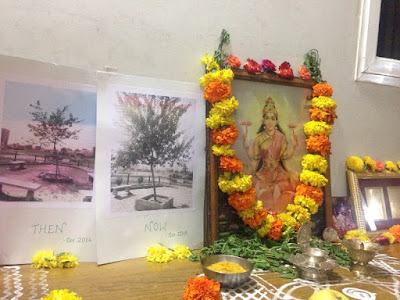We are wary of festivals because of the toll they take on water bodies in general and our lake in particular. Navaratri, however, became special for us since 2013 when a South City resident Raji decided to make our Puttenahalli Lake part of her “Golu.” Invited for haldi kumkum, we walked in and stopped short. What? Our Lake in the Golu? The lake made of chart paper and little figures was almost an exact replica of Puttenahalli Lake. Raji and her son Aditya had anticipated it full of water and their model had an expanse of blue when in reality the lake bed was more green with weeds. This unusual representation during a festival of dolls caught the eye of the press and Jagran City Plus carried this story.
This year Anjana has once again decided to pay her respects to Nature, the Supreme Mother, through Puttenahalli Lake. The photograph above shows the pride of place Anjana has given the lake and also indeed, how much the Sheesham has grown in this one year.
